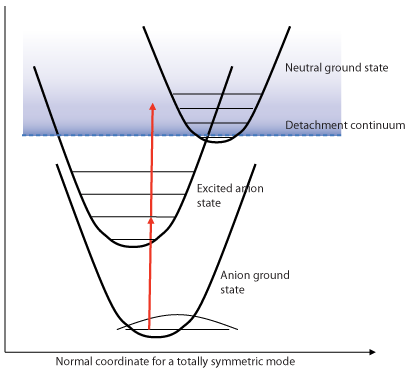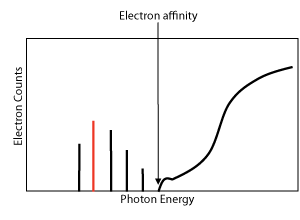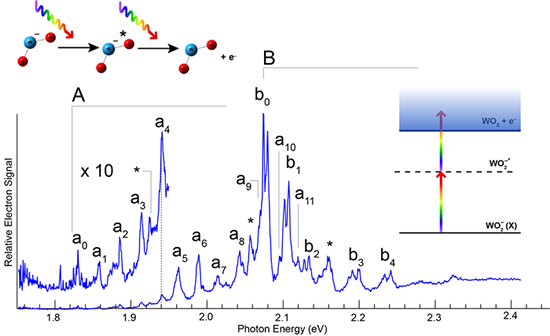Resonant 2-photon Detachment
 Resonant 2-photon Detachment (R2PD) of anions is a new addition to research in the CC Jarrold group. In these experiments, an electron in the anion ground state is excited by one photon, then detached by a second photon of the same energy (see figure to the right). We use a tunable laser for these experiments, a Nd:YAG pumped OPO with an energy output ranging from 410 nm to 709 nm. We are able to record the electron and ion signals as well as laser power as a function of laser wavelength. The electron signal is normalized with respect to the ion signal and laser power. The figure to the right shows an example spectrum that would be obtained. Signal from electrons detached from excited anion states appear below the electron affinity (EA).
Resonant 2-photon Detachment (R2PD) of anions is a new addition to research in the CC Jarrold group. In these experiments, an electron in the anion ground state is excited by one photon, then detached by a second photon of the same energy (see figure to the right). We use a tunable laser for these experiments, a Nd:YAG pumped OPO with an energy output ranging from 410 nm to 709 nm. We are able to record the electron and ion signals as well as laser power as a function of laser wavelength. The electron signal is normalized with respect to the ion signal and laser power. The figure to the right shows an example spectrum that would be obtained. Signal from electrons detached from excited anion states appear below the electron affinity (EA).
R2PD enables us characterize the electronic excited states of anions. Although there are many studies on the excited electronic states of cations, there are considerably fewer studies on the electronic states of anions. The reason for this is in part, because excited states are generally not bound relative to the neutral + e detachment continuum. For closed-shell anions, the EAs tend to lie in the visible or IR region, while electronic excitation energies are typically in the ultraviolet.
 However, there are several classes of anions for which bound excited states are common. For example, bound excited states have been observed in open shell systems, such as the cumulenic carbon chains, in transition metal-containing diatomics and in species in which the neutral dipole moments are sufficiently large to support dipole bound states (DBS). From a computational standpoint, particularly with density functional theory (DFT) calculations, excited states of negative ions tend to be difficult to characterize because of the potentially delocalized nature of high-lying electrons.
However, there are several classes of anions for which bound excited states are common. For example, bound excited states have been observed in open shell systems, such as the cumulenic carbon chains, in transition metal-containing diatomics and in species in which the neutral dipole moments are sufficiently large to support dipole bound states (DBS). From a computational standpoint, particularly with density functional theory (DFT) calculations, excited states of negative ions tend to be difficult to characterize because of the potentially delocalized nature of high-lying electrons.
 There have been several notable studies on excited states of anions where either valence bound or dipole-bound states were observed. Lineberger and coworkers have studied conventional valence-bound states of C2 using resonant two-photon detachment. Maier and coworkers have also probed anion states of CnHm anions, many of which were believed to have DBS character. Additionally, there have been several spectroscopic investigations on more conventional DBS’s of anions, which are typically bound by less than 100 cm−1 with respect to the neutral + e− continuum. Dipole-bound electrons are bound in a delocalized (e.g., 50 Å) orbital on the positive end of a neutral with a >2 Debye dipole moment, and are similar to Rydberg electrons in that both generally do not penetrate their respective neutral or cationic cores. Consequently, the dipole bound anion and associated neutral structures and vibrational frequencies tend to be very similar. Unlike Rydberg states there is usually only one or very few DBS’s that are supported in the dipole field of a given neutral molecule.
There have been several notable studies on excited states of anions where either valence bound or dipole-bound states were observed. Lineberger and coworkers have studied conventional valence-bound states of C2 using resonant two-photon detachment. Maier and coworkers have also probed anion states of CnHm anions, many of which were believed to have DBS character. Additionally, there have been several spectroscopic investigations on more conventional DBS’s of anions, which are typically bound by less than 100 cm−1 with respect to the neutral + e− continuum. Dipole-bound electrons are bound in a delocalized (e.g., 50 Å) orbital on the positive end of a neutral with a >2 Debye dipole moment, and are similar to Rydberg electrons in that both generally do not penetrate their respective neutral or cationic cores. Consequently, the dipole bound anion and associated neutral structures and vibrational frequencies tend to be very similar. Unlike Rydberg states there is usually only one or very few DBS’s that are supported in the dipole field of a given neutral molecule.
Our first R2PD experiment was on WO2−. The R2PD spectrum and PE spectrum of WO2− are shown to the right. We observed two distinct electronic states below the detachment continuum of WO2. From the R2PD spectrum, we were able to determine bend frequencies of the WO2− ground and excited states. These frequencies are significantly lower than the bend frequencies of the ground and low-lying neutral states of WO2, which contraindicates assigning the two bands to conventional DBS’s. Tentatively, we assign these states to valence-bound states of the anion based both on the low bend frequencies observed in the spectra, as well as the relatively large energy interval between the R2PD features and the most comparable features observed in the anion PE spectra. More details on this experiment and our findings can be found in our paper “Resonant two-photon detachment of WO2−“, Jennifer E. Mann, Sarah E. Waller, David W. Rothgeb and Caroline Chick Jarrold, Chemical Physics Letters, 506, 31 (2011).
 The R2PD spectrum and PE spectrum of WO2− are shown to the right. We observed two distinct electronic states below the detachment continuum of WO2. From the R2PD spectrum, we were able to determine bend frequencies of the WO2− ground and excited states. These frequencies are significantly lower than the bend frequencies of the ground and low-lying neutral states of WO2, which contraindicates assigning the two bands to conventional DBS’s. Tentatively, we assign these states to valence-bound states of the anion based both on the low bend frequencies observed in the spectra, as well as the relatively large energy interval between the R2PD features and the most comparable features observed in the anion PE spectra. More details on this experiment and our findings can be found in our paper “Resonant two-photon detachment of WO2−“, Jennifer E. Mann, Sarah E. Waller, David W. Rothgeb and Caroline Chick Jarrold, Chemical Physics Letters, 506, 31 (2011).
The R2PD spectrum and PE spectrum of WO2− are shown to the right. We observed two distinct electronic states below the detachment continuum of WO2. From the R2PD spectrum, we were able to determine bend frequencies of the WO2− ground and excited states. These frequencies are significantly lower than the bend frequencies of the ground and low-lying neutral states of WO2, which contraindicates assigning the two bands to conventional DBS’s. Tentatively, we assign these states to valence-bound states of the anion based both on the low bend frequencies observed in the spectra, as well as the relatively large energy interval between the R2PD features and the most comparable features observed in the anion PE spectra. More details on this experiment and our findings can be found in our paper “Resonant two-photon detachment of WO2−“, Jennifer E. Mann, Sarah E. Waller, David W. Rothgeb and Caroline Chick Jarrold, Chemical Physics Letters, 506, 31 (2011).
We plan to expand our R2PD studies to bimetallic systems and reactive products.


 The College of Arts
The College of Arts